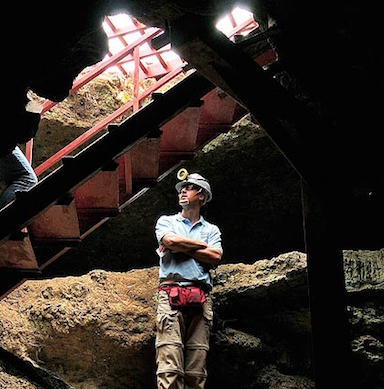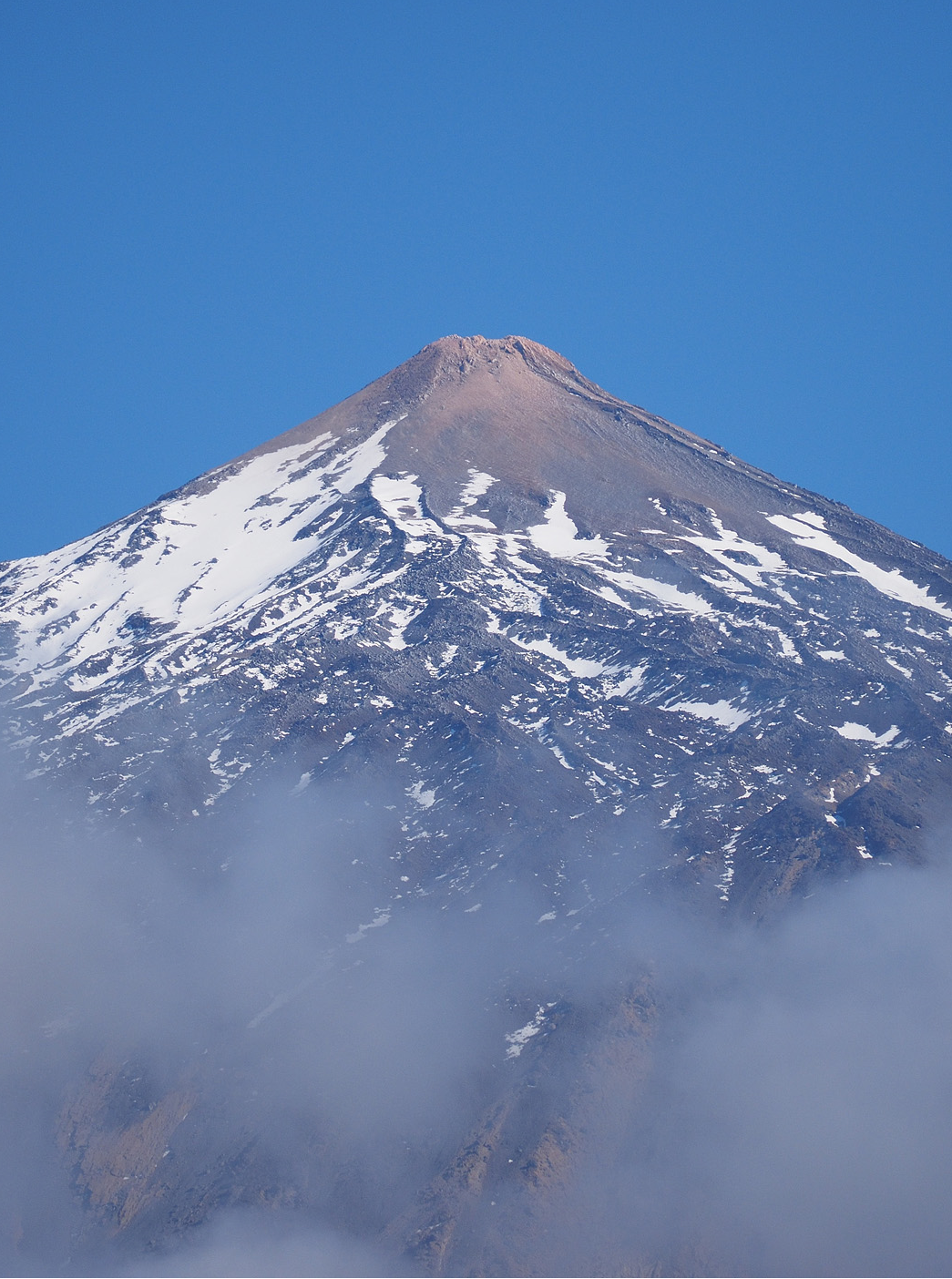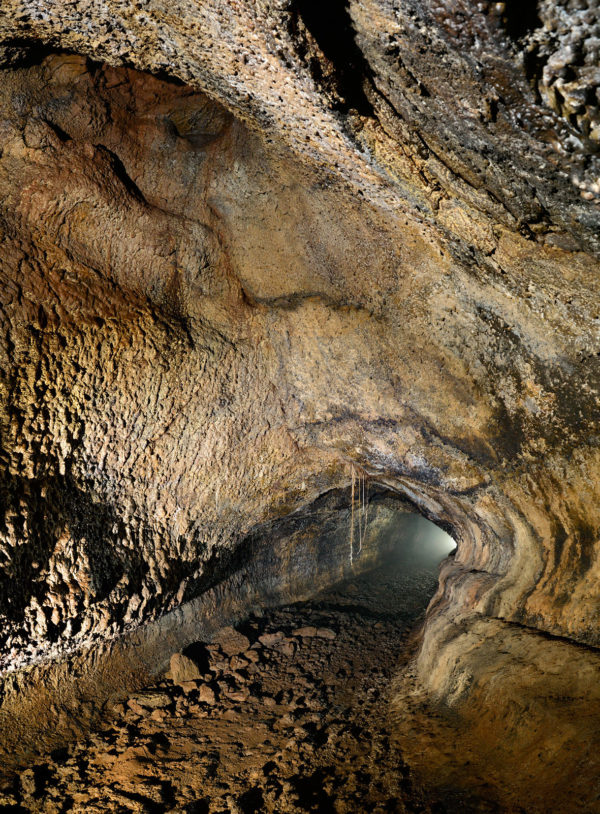La Grotte
PROTECTION
Seuls trois tubes volcaniques possèdent une protection spécifique pour cette condition aux Canaries : deux à Lanzarote (Jameos del Agua et la Cueva de los Naturalistas) et un autre à La Palma (Tubo del Todoque). En outre, un grand nombre de cavités se trouvent dans le domaine de protection de plusieurs Espaces Naturels Protégés. Mais cette protection peut être améliorée vu que souvent, du fait de ne pas être inventoriées, elles sont exposées à des situations nuisibles, comme l’ouverture de pistes, ou tout simplement, on n’envisage pas des mesures directes pour leur conservation.
L’adaptation du Plan d’Aménagement des Ressources Naturelles (PORN) Cueva del Viento à la réglementation des Zones Européennes Spéciales de Conservation a été publiée en 2014.

descripction
La Cueva del Viento est une cavité volcanique située dans le quartier d’Icod de los Vinos portant le même nom, et formée il y a 27 000 ans dans la lave basaltique provenant de la première phase éruptive du volcan Pico Viejo, situé à côté du Teide (Tenerife, Iles Canaries).
Ce tube volcanique, dont le nom provient des grands courants d’air qui se produisent à l’intérieur, est le cinquième plus long tube du monde (18 kilomètres topographiés) après les quatre premiers qui se trouvent dans la plus grande île de l’Archipel de Hawaii (Etats-Unis). Il constitue un énorme réseau labyrinthique de passages souterrains qui rendent incalculable le nombre de ramifications inexplorées qui permettraient d’amplifier, dans le futur, son étendue.
La Cueva del Viento se démarque également par ses caractéristiques géomorphologiques uniques vu que son réseau de galeries se déploie sur trois niveaux superposés, phénomène que l’on ne peut admirer nulle part ailleurs dans le monde. En outre, elle présente une grande variété de structures d’origine primaire telles que stalactites de lave, cascades de lave, terrasses latérales et lacs de lave, entre autres, ou encore des concrétions exogènes à composition différente (carbonate de calcium et autres sels).
La particularité biologique la plus importante de cette cavité volcanique inextricable est sa faune souterraine qui représente une source constante de nouvelles découvertes. La grotte accueille un total de 190 espèces communes, la plupart invertébrées, 44 étant des espèces troglobies, c’est-à-dire, des animaux adaptés au milieu souterrain. Parmi ces espèces condamnées à vivre dans l’obscurité, 15 sont toutes nouvelles pour la science, comme le cafard sans yeux, Loboptera subterrane, ou les carabidés Wolltinerfia martini et Wolltinerfia tenerifae.
A l’intérieur se trouvent certains restes fossiles d’animaux vertébrés déjà disparus, comme le rat ou le lézard géant, ainsi que d’autres restes osseux d’espèces déjà disparues à Tenerife, comme le corbeau freux ou l’Outarde houbara.
Afin de garantir leur conservation, le Gouvernement des Canaries approuva en 1998 un Plan d’Aménagement des Ressources Naturelles de la Cueva del Viento, étape préalable à sa déclaration comme Réserve Naturelle Spéciale. Le plan a été conçu pour freiner toute action pouvant porter préjudice à la grotte, telle que nouvelles constructions, altération du sol ou tout type de déchet. Il établit en outre des mesures d’amélioration, telles qu’un réseau d’égouts évitant le déversement d’eaux usées et le soutien à la recherche scientifique ou à l’éducation environnementale.


History

Cueva del Viento (Cave of the Wind) was already known to the Guanches more than 2,000 years ago: burial remains have been found in the cave. But no written record exists until 1776. That year, the Bethencourt de Castro brothers and Afonso Molina mentioned it in their description of the San Marcos Cave. The main entrance to the cave is located in the neighbourhood of the same name, Cueva del Viento, which would suggest that it had already been known to the locals for a long time.
The history of recent discoveries began in 1969 with deep exploration and the publication in 1970 of the first map, of just over 6km, by the La Guancha caving section of the Montañero de Tenerife mountaineering group. In 1973, cavers from the Shepton Mallet Caving Club discovered what was later to be named, in their honour, the “Pozo de los Ingleses” (“Englishmen’s Pit”), which connects the third level with a large gallery of about 4 kilometres in length on the lowest level. Thanks to this important find, the cavity grew considerably in size, to an overall length of 10 kilometres.
Years later the University of La Laguna Department of Zoology began to conduct biological studies, and discovered a great variety of cave fauna. In addition, the Benisahare Tenerife Caving Group discovered and mapped new galleries.
In 1989, this same group connected Cueva del Viento with the Sobrado cave through narrow passages, making the total length of the complex 14 kilometres. This discovery enhanced the status of the great volcanic complex, and plans were made to remap all the branches.
In 1994 works began to prepare the lava tube for the public. These were coordinated by the Museum of Natural Sciences, part of the Independent Board of Museums and Centres of the Tenerife Island Council. One of their first actions was to clear away the rubble from the mouth of one of the tube branches. This excavation exposed a 17-metre-deep chasm, with a lava cascade, connecting to another level of the lava tube, with a length of 2.35 kilometres.
These findings give us just a hint of the rich heritage and great geological significance of this major underground complex, which is certain to hold many more surprises in store.
Caving in the Canaries is a relatively new activity that began in the late sixties and Cueva del Viento has written memorable pages of this burgeoning history. The pioneers were members of the Montañero de Tenerife Group, followed by the La Guancha Volcano Cave Exploration Section.
And so the study of this cavity gave rise to volcano caving on the Canary Islands. The two years that the exploration and mapping of the Icod tube lasted was the ideal learning environment for many of the island’s future vulcanospeleologists.
In 1978, the Benisahare Tenerife Caving Group was born. It was the first group specifically dedicated to caving in the Canaries and took over exploration of Cueva del Viento. Their work on vulcanospeleology has been presented at National and International Speleology Conferences, widely promoting knowledge of this wonderful sport/science in the Canary Islands.
Thanks to their work, the Canary Islands School of Speleology was born alongside new groups and sections of this specialised discipline in the rest of the archipelago.
Biologie

Cueva del Viento is home to significant biological treasures and is a unique place for studying animals that are now locally extinct on the island of Tenerife.
The underground environment is characterised by total darkness, very high humidity levels, a constant temperature and almost absolute stillness. No light, no green plants and no organic matter, so what little food there is has to come from outside. Roots that penetrate from above through cracks, animals that accidentally enter the cave or sediment carried by the water that percolates through the earth.
In order to survive in these conditions cave species have had to evolve and produce adaptations that differentiate them from their aboveground relatives. These modifications arise as certain organs become unnecessary for the organism and it adapts to expend less energy in this dark world. An example is reproduction in cave species, which produce fewer eggs but provide them with greater reserves to ensure the survival of the young in an environment with so little food.
The study of these adaptations has its own particular history in Cueva del Viento. Already, in the 1970s, experts were theorising the existence of troglobite insects (cave-dwelling animals), although zoologists had never visited the cave. Biological studies were first carried out thanks to the discovery of subfossil bones of the now extinct giant lizard, Gallotia goliath, and giant rat, Canariomys bravoi.
This finding was followed by the discovery of various troglobitic species that were hitherto unknown in the Canary Islands, including the eyeless cockroach Loboptera subterranea and the ground beetles Wolltinerfia martini and Wolltinerfia tenerifae, which were new to science. This phenomenon is common in caves of this type, and the animals that have adapted to life in them are unable to survive outside of that environment.
In 1982, a group of biologists from the University of La Laguna conducted a thorough study of the cave. They found that saprophages (or detritivores, meaning they feed on detritus) were by far the most abundant creatures. This study was carried out only on the highest level, specifically in the Belén, Breveritas Superior, Breveritas Inferior and Breveritas Profunda galleries. They discovered 37 animal species, of which 9 were troglobites. In 1987 an extremely thorough, detailed and rigorous new study was carried out, leading to the discovery of more species, bringing the total to 43.
In this type of cave animals live by the maxim “adapt or die” and quite incredible changes come about, such as body discoloration or vision loss. In some cases, such as that of the woodlouse Venezillo tenerifensis, pigmentation disappears altogether, as there is no need for it without sunlight.
As it is not possible to see in pitch black darkness, sometimes their eyes atrophy and even disappear entirely. This is the case of a type of cave cockroach (Loboptera troglobia) which has lost its sight; moreover, its skin is sensitive to light, so it avoids lit areas.
Other animals develop other senses to compensate their blindness. This is the case of the beetle Domene vulcanica whose long antennae gives it a heightened sense of smell and a delicate sense of touch that make up for its lack of eyesight, and its streamlined legs and body help it on its endless march in search of scarce food. Moreover, because food is so scarce in cave environments, these animals can fast for months thanks to their slow metabolism, as is the case of the cave-dwelling spider Canarionesticus quadridentatus.
Species for which subfossils have been found in Cueva del Viento include: the giant lizard, Gallotia goliath, and the giant rat, Canariomys bravoi, both of which are exclusive to Tenerife; the long-legged bunting (Emberiza alcoveri), only ever found in Cueva del Viento; the extinct Canary Islands quail (Coturnix gomerae), which has also been found on La Gomera; and the red-billed chough (Pyrrhocorax pyrrhocorax) which currently only lives on La Palma.
Vegetation occupies three sections: the external zone, with vascular plants and some ferns and lichens; the entrance zone, which begins at that point the rain does not directly reach, but does receives light and contains mainly mosses and lichens; and the transition zone, which receives indirect light, where cyanobacteria and lichens are found.
Geologie
With regard to the process that causes this type of lava tube, the structures are typical of certain types of basaltic flow, where constant heat inside the flow pushes it forwards. Heat conservation is guaranteed by a continuous crust that thermally insulates the inner lava and within which conduits form. After the eruption, the lava continues to flow through these conduits until they empty. Cueva del Viento contains three levels of conduit produced by successive eruptive stages which created overlapping flows within which the galleries formed.
27,000 years ago, during the basaltic emissions of the first eruptive phase of Pico Viejo, the great lava channels were formed and these became two spacious galleries: the Los Ingleses and Sobrado Inferior galleries. After these solidified, another flow covered the surface, still devoid of soil or vegetation. A third level of flows created a maze of conduits that frequently interconnect with the Sobrado and Cueva del Viento caves.

